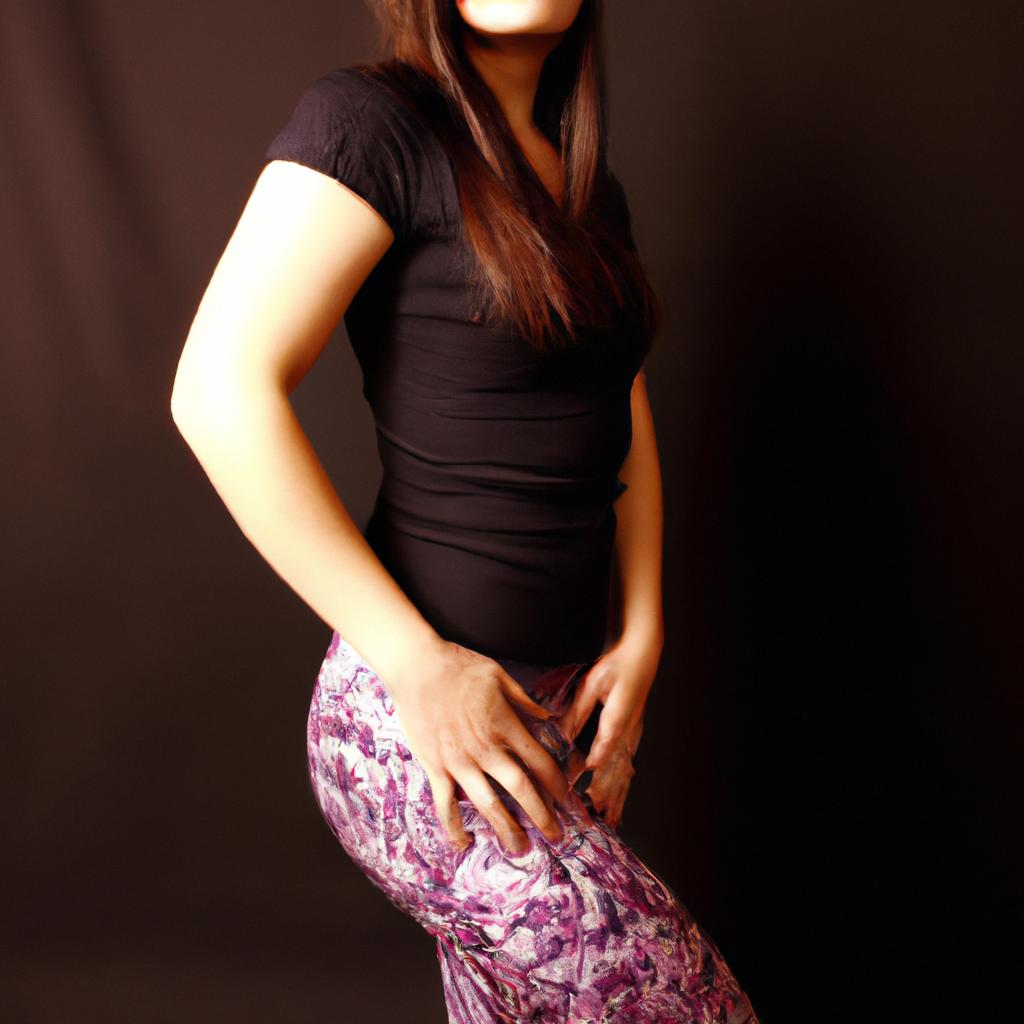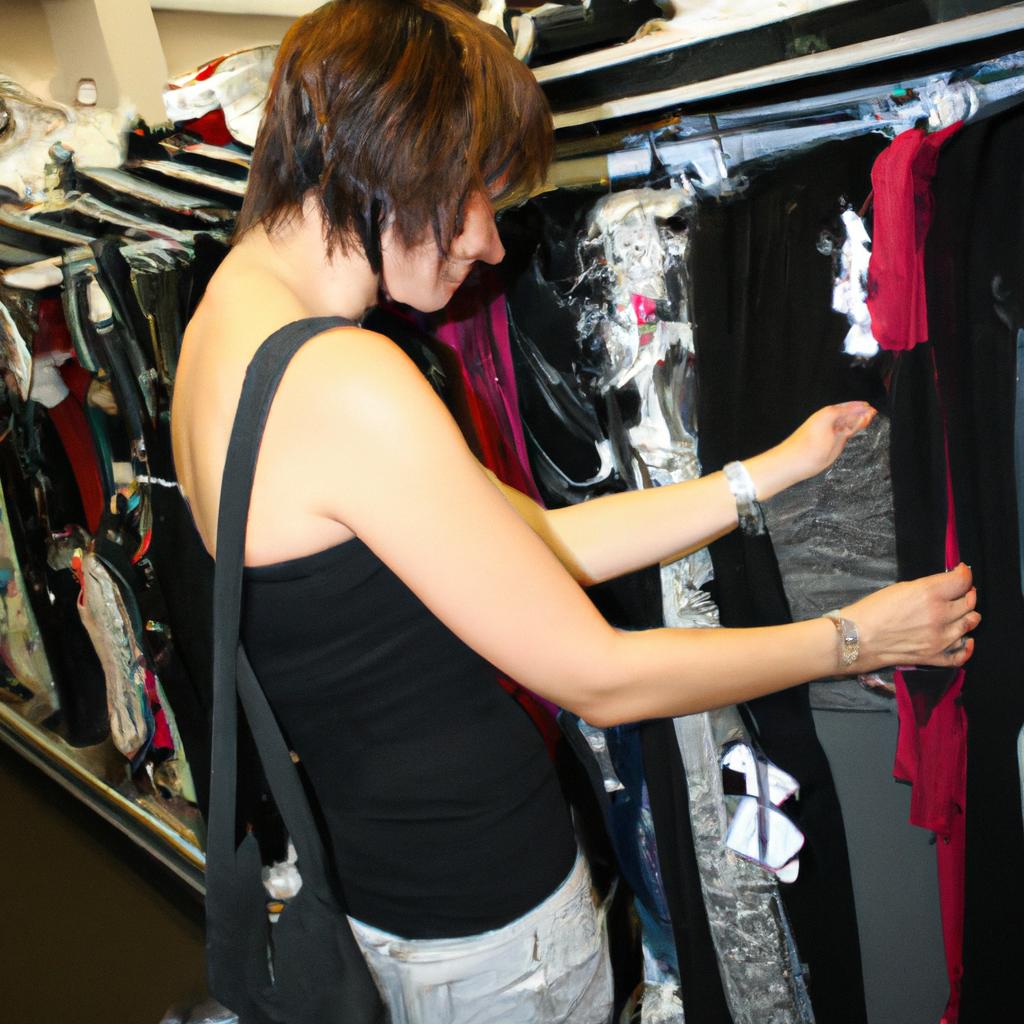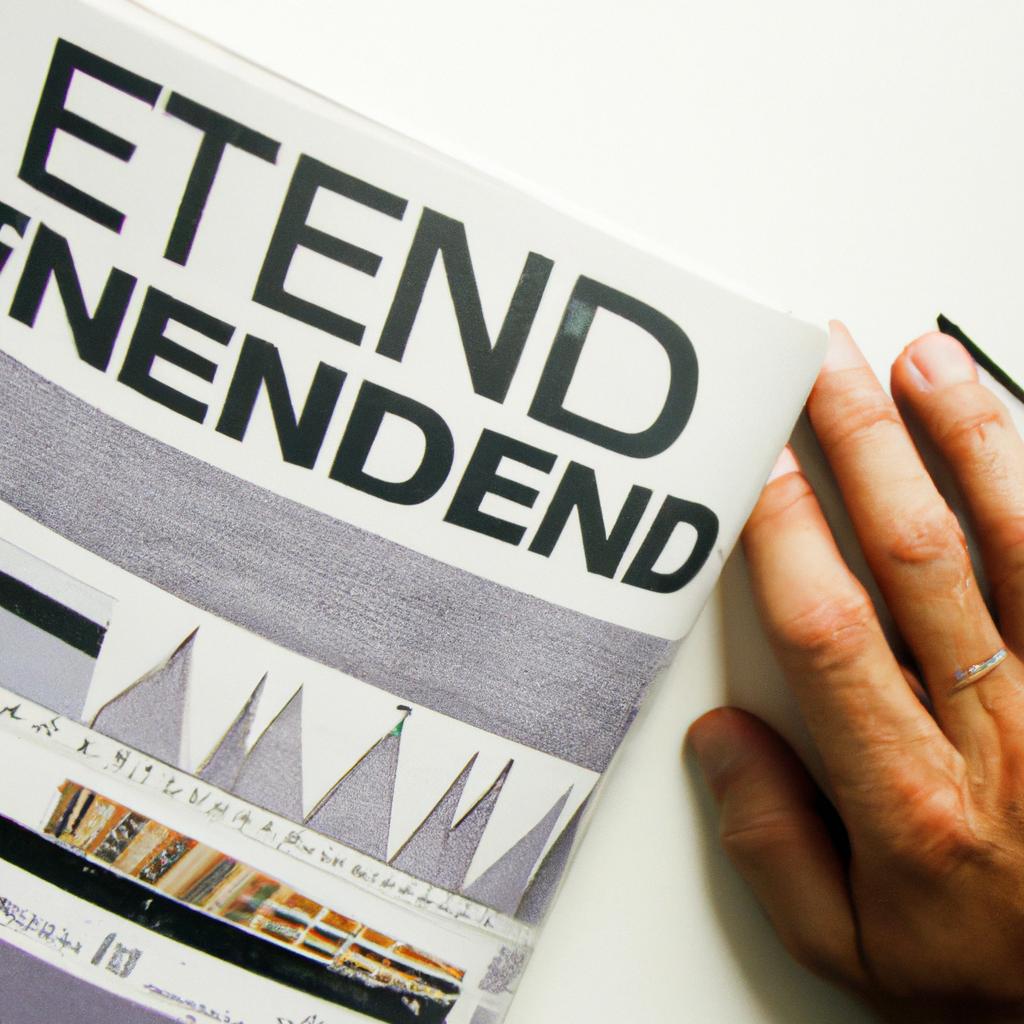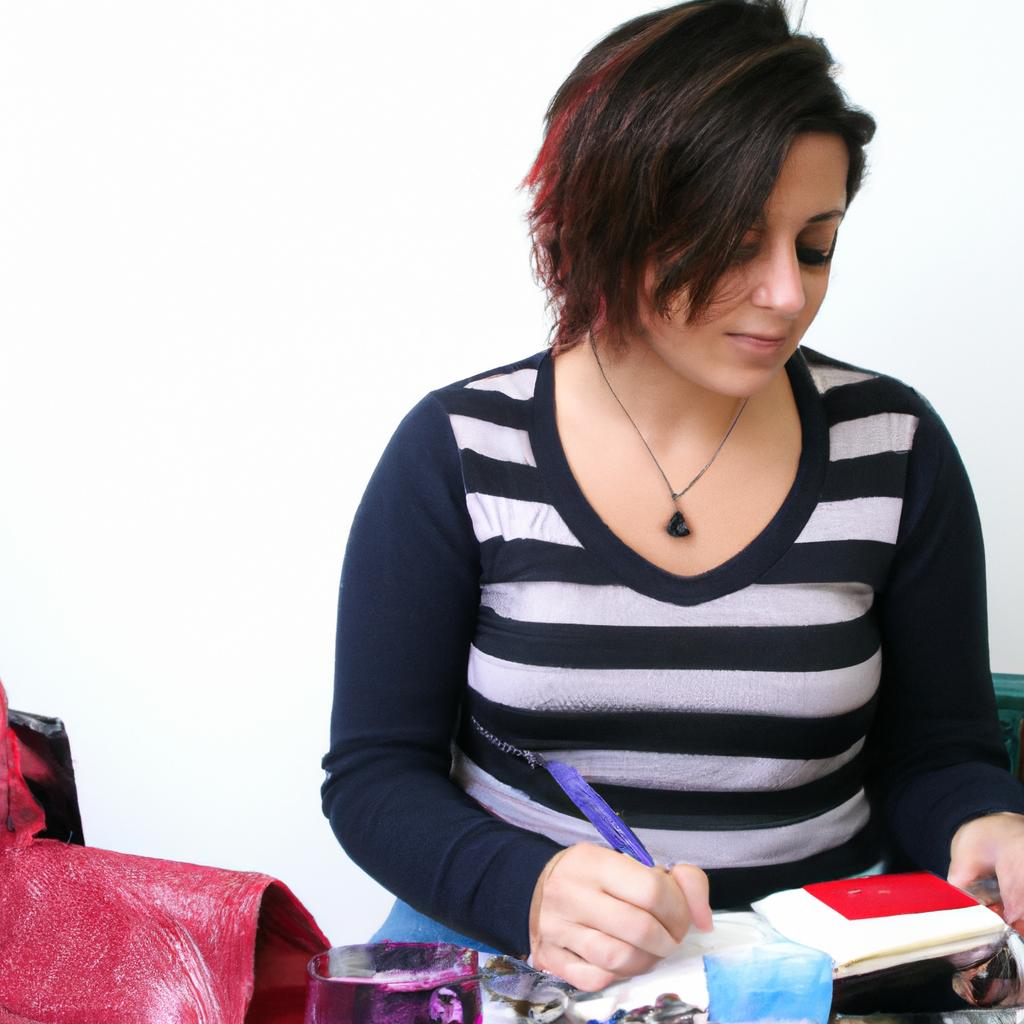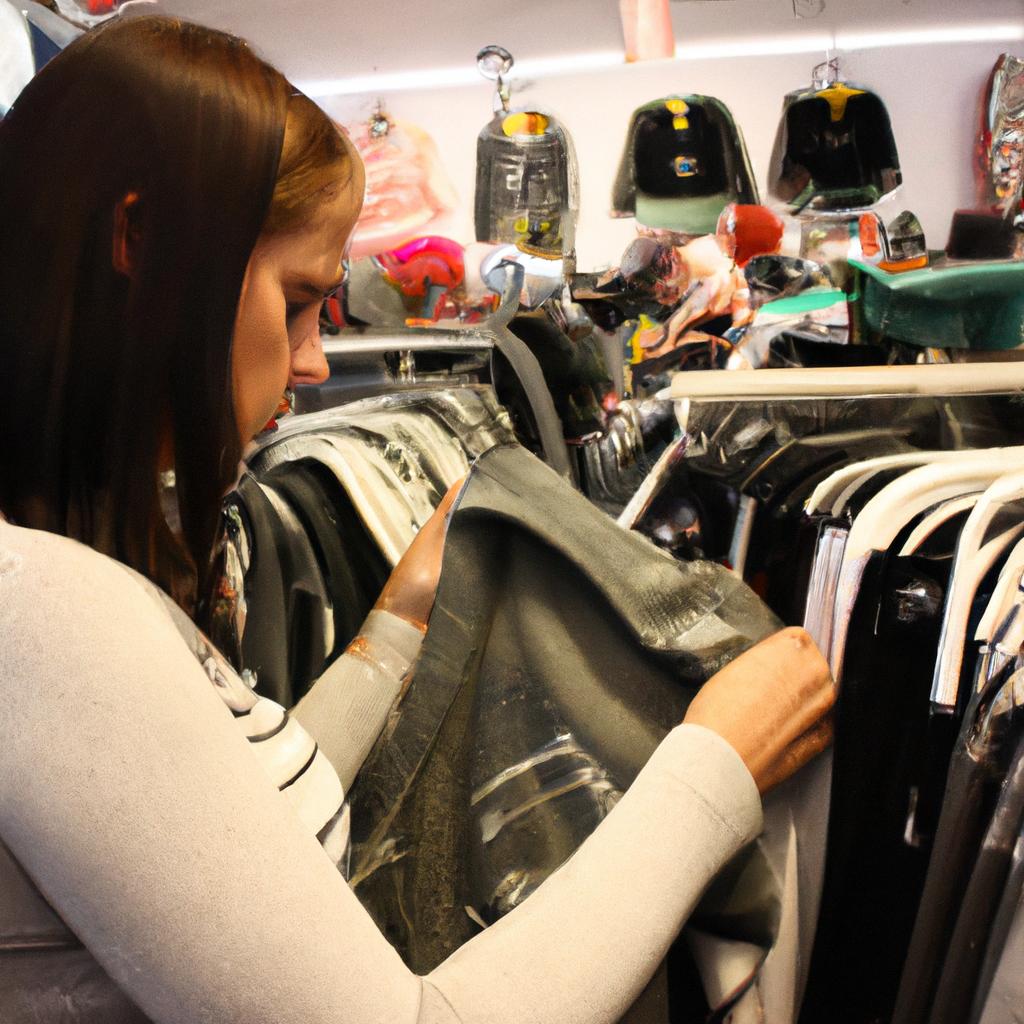Fashion Finance: The Economics Behind Women’s Clothing

The world of fashion is often admired for its creativity and glamour, but behind the scenes lies a complex web of economic forces that drive the women’s clothing industry. From high-end designer labels to fast-fashion retailers, every aspect of this multi-billion-dollar business is shaped by financial considerations. For instance, consider the case study of a luxury brand like Chanel. The iconic double-C logo and timeless designs are not only synonymous with sophistication but also command exorbitant prices. This example illustrates how pricing strategies in the fashion industry are carefully devised to create an aura of exclusivity while maximizing profits.
Beyond individual brands, there are broader economic factors at play within the realm of women’s clothing. One such factor is consumer demand, which heavily influences production and distribution decisions. Understanding what drives consumers’ choices can shed light on why certain styles or trends become popular while others fizzle out quickly. Moreover, supply chain management plays a crucial role in ensuring efficient production and delivery of garments to meet market demands. From sourcing raw materials to managing factories and logistics, streamlining these processes becomes essential for manufacturers seeking profitability in a highly competitive market.
In addition to internal dynamics, external factors such as global trade policies and currency fluctuations have significant implications for the fashion finance landscape. Tariffs imposed by governments on imported textiles and garments can impact the cost of production and ultimately affect pricing strategies. Currency fluctuations, on the other hand, can influence the profitability of international fashion brands that rely on sales in multiple countries. For example, a strong currency can increase the price of imported materials or make products more expensive for foreign consumers, potentially reducing demand.
Furthermore, financing plays a crucial role in sustaining operations within the women’s clothing industry. Fashion companies often require capital to invest in research and development, marketing campaigns, manufacturing facilities, and retail expansion. They may obtain this funding through various means such as bank loans, venture capital investments, or partnerships with private equity firms. Managing cash flow effectively is also essential to ensure ongoing operations and cover expenses like employee salaries, rent, and utilities.
Overall, understanding the financial aspects of the women’s clothing industry is vital for both businesses operating within it and consumers interested in its inner workings. By recognizing how economic forces shape fashion trends, pricing strategies, supply chains, trade policies, and financing decisions, one can gain valuable insights into this complex yet fascinating world.
Understanding the Dynamics of Fashion
Fashion is a complex and ever-evolving industry that encompasses not only style trends but also economic principles. To comprehend the dynamics of fashion, it is essential to explore its intricate relationship with consumer behavior, supply chain management, and market demand.
One way to understand this dynamic is by examining the phenomenon of fast fashion. Fast fashion refers to the rapid production and consumption of inexpensive clothing items inspired by runway trends. For instance, consider the case study of a popular retail brand that releases new collections every week at affordable prices. This strategy capitalizes on consumers’ desire for up-to-date styles while keeping costs low through mass production and efficient supply chains.
To delve further into the intricacies of fashion economics, four key factors contribute to shaping consumer behavior in this industry:
- Seasonality: The cyclical nature of fashion dictates that certain styles are more desirable during specific times of the year. Consumers adapt their purchasing habits accordingly, resulting in fluctuations in demand and inventory management challenges for retailers.
- Branding: Strong branding plays a pivotal role in attracting customers to particular fashion labels. By creating an emotional connection between consumers and their products, brands can establish long-term loyalty and influence purchasing decisions.
- Social Influence: Peer pressure and societal norms greatly impact individuals’ choices regarding clothing purchases. The desire to fit in or stand out within social circles can drive consumer behavior towards specific brands or styles.
- Price Perception: Perceived value often influences purchase decisions in the fashion industry. Consumers may associate higher price points with better quality or exclusivity, thus affecting their willingness to pay for certain garments.
To illustrate these factors visually, we can use a table as follows:
| Factor | Description |
|---|---|
| Seasonality | Fluctuations in demand based on seasonal changes |
| Branding | Emotional connections between consumers and specific fashion labels |
| Social Influence | Peer pressure and societal norms influencing fashion choices |
| Price Perception | Perceived value affecting willingness to pay for certain garments |
Understanding the dynamics of fashion sheds light on how economic principles shape this industry. By recognizing consumer behavior patterns, supply chain management challenges, and market demand fluctuations driven by factors such as seasonality, branding, social influence, and price perception, stakeholders in the fashion world can make more informed decisions.
Transitioning into the subsequent section about “The Impact of Social Media on Style,” we can explore how technological advancements have revolutionized the way consumers engage with fashion trends and brands.
The Impact of Social Media on Style
Transitioning from the previous section on understanding the dynamics of fashion, let us now delve into another crucial aspect that shapes women’s clothing choices: the impact of social media on style. To illustrate this influence, imagine a hypothetical scenario where a popular fashion influencer shares an outfit post on Instagram featuring a trendy dress from a particular brand. This post garners thousands of likes and comments, with users expressing their admiration for the garment and asking where they can purchase it. Almost instantly, this dress becomes highly sought after, prompting a surge in demand and potentially leading to increased sales for the brand.
The rise of social media platforms has revolutionized how consumers interact with fashion brands and each other. It has created new avenues for trendsetters to showcase their personal style while simultaneously providing inspiration to millions of individuals worldwide. The impact is undeniable; what was once limited to traditional fashion shows or magazines is now accessible at one’s fingertips through smartphone apps and websites. Social media influencers have become powerful driving forces behind consumer behavior, as their recommendations often hold significant sway over purchasing decisions.
To understand why social media has such a profound effect on style trends, we must consider several key factors:
- Accessibility: Social media allows users to discover new brands and styles effortlessly by following profiles aligned with their interests. This exposure opens doors to lesser-known designers who may not have had access to traditional advertising methods.
- Peer Influence: Seeing others wearing certain items creates a sense of social validation and encourages individuals to participate in these trends themselves.
- Speed of Information: With just a few clicks, users can share images and information about emerging trends instantaneously across various platforms, reaching vast audiences within seconds.
- Interactive Engagement: Users can engage directly with influencers through comments or direct messages, fostering connections that make them feel more involved in the fashion community.
Consider the following table highlighting statistics related to social media’s impact on fashion:
| Statistics | Impact on Fashion |
|---|---|
| 1. Over 3 billion people use social media worldwide | Widens reach for brands and trends |
| 2. Instagram influencers are estimated to have a $1.7 billion market in 2020 | Demonstrates the influence of individuals |
| 3. Social media users spend an average of 144 minutes per day on these platforms | Reflects the extensive engagement with fashion content |
| 4. The hashtag #OOTD (Outfit Of The Day) has over 200 million posts on Instagram alone | Showcases the popularity of sharing personal style |
As we can see, social media’s impact on women’s clothing choices is multifaceted and far-reaching. It plays a pivotal role in shaping trends, amplifying brand visibility, and fostering interactive communities centered around fashion.
Transitioning into analyzing the influence of celebrities on fashion, it is important to understand how their prominence intersects with the power of social media in shaping sartorial preferences.
Analyzing the Influence of Celebrities on Fashion
Transitioning from our discussion on the impact of social media on style, it is important to delve into the influence that celebrities have had on shaping fashion trends. One notable example in recent years is the rise of a certain actress who effortlessly combines elegance with edginess in her red carpet appearances. Her unique sense of style has captivated millions and resulted in numerous clothing lines collaborating with her to recreate her iconic looks.
The influence of celebrities on fashion can be observed through several key factors:
-
Red Carpet Events: When celebrities attend prestigious events like award shows or film festivals, their choice of attire becomes highly influential. Designers compete for the opportunity to dress these stars, as their creations are then showcased to a global audience, leading to increased popularity and demand for those styles.
-
Endorsements: Many celebrities endorse specific brands or products, lending their image and credibility to promote them. This association often leads consumers to aspire towards owning similar items, further fueling sales and creating trends around those endorsed products.
-
Street Style: Celebrities’ off-duty outfits captured by paparazzi photographers generate immense interest among fashion enthusiasts. These candid snapshots showcase how they interpret current trends in their everyday lives, providing inspiration and guidance for fans seeking to emulate their favorite celebrity’s style.
-
Social Media Presence: Just like ordinary individuals, celebrities also utilize social media platforms to share glimpses into their personal lives and fashion choices. With millions of followers eagerly waiting for updates, every outfit they post becomes an instant trendsetter, influencing countless others searching for new ways to express themselves through clothing.
To exemplify this phenomenon further, let us consider a hypothetical scenario where a popular actress wears a statement necklace during a major awards ceremony. Within days, retailers notice a significant surge in demand for similar necklaces as people desire to replicate the star’s glamorous look.
| Key Factors of Celebrity Influence on Fashion |
|---|
| Red Carpet Events |
| Endorsements |
| Street Style |
| Social Media Presence |
It is evident that celebrities hold considerable sway over the fashion industry, shaping trends and consumer behavior. As we move forward in our exploration of fashion economics, it is crucial to understand not only how external influences impact our clothing choices but also the underlying psychology behind shopping for clothes.
Understanding the influence of celebrities on fashion opens a gateway into exploring the psychology behind shopping for clothes without compromising personal style preferences.
The Psychology of Shopping for Clothes
The impact of celebrities on fashion trends cannot be underestimated. Their choices and preferences in clothing have a significant influence on consumer behavior, shaping the way people dress and shop for clothes. One notable example is when Meghan Markle, the Duchess of Sussex, wore an affordable white wrap coat during her engagement announcement with Prince Harry. This led to a surge in demand for similar coats, causing retailers to quickly stock up to meet consumer needs.
When examining the influence of celebrities on fashion, several key factors come into play:
-
Celebrity endorsements: Many brands collaborate with celebrities to promote their products. A celebrity’s association with a specific brand can create immediate recognition and desirability among consumers who admire them.
-
Red carpet events: Celebrities often set trends through their red carpet appearances at prestigious award ceremonies such as the Oscars or Met Gala. These high-profile events attract extensive media coverage, allowing designers’ creations to gain widespread attention and subsequently influence consumer choices.
-
Social media presence: With the rise of social media platforms like Instagram and Twitter, celebrities now have direct access to millions of followers around the world. By sharing their daily outfits or collaborating with fashion influencers, they can easily reach a vast audience and shape popular fashion trends.
-
Paparazzi culture: The constant scrutiny faced by celebrities from paparazzi photographers means that every outfit they wear becomes subject to public discussion and analysis. As a result, individuals looking for style inspiration turn to these images for ideas on what’s fashionable.
Through this interplay between celebrities and fashion, consumers are driven by both admiration for famous figures and the desire to stay current with popular trends. To further understand how these influences affect our shopping habits, let us delve into the psychology behind purchasing clothes in the next section.
| Psychological Effects of Fashion Trends |
|---|
| 1 |
| 2 |
| 3 |
| 4 |
Understanding the psychology behind shopping for clothes is crucial when examining how celebrities influence our purchasing decisions. By tapping into consumers’ desire for social validation, self-expression, confidence boosts, and emotional connections through fashion trends, celebrities effectively shape what we buy and wear.
Transitioning into the subsequent section on “Identifying Fashion Trends and Predicting their Lifespan,” it becomes evident that analyzing the role of celebrities in influencing fashion is just one aspect of understanding the ever-changing landscape of women’s clothing.
Identifying Fashion Trends and Predicting their Lifespan
Building on our understanding of the psychology behind shopping for clothes, let us now delve into the process of identifying fashion trends and predicting their lifespan.
Identifying Fashion Trends and Predicting Their Lifespan
To illustrate this concept, consider a hypothetical scenario where a new fashion trend emerges— oversized blazers. Initially popularized by influential celebrities and tastemakers, these statement pieces quickly gain traction among consumers seeking to stay ahead in the ever-evolving world of fashion. As we explore the mechanisms that contribute to the rise and fall of such trends, several key factors come into play:
-
Influencer Marketing:
- Celebrities endorse oversized blazers through social media platforms.
- Online influencers share outfit inspiration featuring this style.
- Consumers are motivated to emulate their favorite icons’ looks.
-
Media Exposure:
- Fashion magazines feature editorials highlighting oversized blazers.
- Television shows and movies showcase characters donning this trend.
- Street style photographers capture individuals wearing these fashionable garments during major events.
-
Consumer Demand:
- People perceive oversized blazers as a symbol of confidence and power.
- The desire to be perceived as trendy leads consumers to purchase them.
- Retailers respond by increasing production and availability of oversized blazers.
-
Market Saturation:
- Oversized blazer options flood the market across various price points.
- Consumers become accustomed to seeing this trend everywhere.
- Eventually, oversaturation decreases consumer interest, leading to its decline.
Table: Factors Affecting Trend Lifespan
| Factors | Examples |
|---|---|
| Influencers | Celebrity endorsements |
| Media exposure | Magazine features |
| Consumer demand | Perceived confidence boost |
| Market saturation | Wide availability |
As we observe the lifecycle of fashion trends like oversized blazers, it becomes evident that they often follow a predictable pattern. While some trends may experience prolonged popularity, others fade away relatively quickly. This dynamic nature of fashion necessitates the continuous identification and analysis of emerging trends to stay relevant in the industry.
Understanding how fashion trends come into existence and evolve leads us to explore the role of branding in fashion consumption, where brands play a vital part in shaping consumer preferences and choices.
The Role of Branding in Fashion Consumption
In the ever-evolving world of fashion, identifying trends and predicting their lifespan is crucial for both consumers and industry insiders. By understanding how fashion trends emerge and evolve, individuals can make informed decisions about their clothing purchases, while businesses can strategically plan their product offerings. Let us explore this fascinating process by examining a hypothetical case study.
Consider the rise of athleisure wear in recent years. This trend emerged from the growing desire among consumers to combine comfort with style, blurring the lines between activewear and everyday clothing. Initially popularized by celebrities sporting athletic apparel outside the gym, athleisure quickly gained traction among fashion enthusiasts worldwide. As a result, numerous brands began incorporating elements of sportswear into their collections, catering to this newfound demand.
To better understand the dynamics behind fashion trends, it is essential to consider several factors that contribute to their emergence and potential longevity:
- Celebrity Influence: The endorsement or adoption of a certain style by influential figures often propels a trend into the mainstream consciousness.
- Cultural Shifts: Social movements or changes in societal attitudes towards specific themes (such as sustainability or gender equality) can shape emerging fashion trends.
- Runway Shows: Fashion weeks held in major cities provide platforms for designers to showcase innovative designs that subsequently influence consumer preferences.
- Street Style: Observing what people are wearing on the streets offers valuable insights into current fashion trends beyond traditional runway shows.
To illustrate these points further, let’s take a look at some examples:
| Trend | Celebrity Influencer | Key Designers | Notable Street Style |
|---|---|---|---|
| Athleisure Wear | Rihanna | Alexander Wang, Stella McCartney | Sporty sneakers paired with tailored pieces |
As we delve deeper into analyzing fashion trends’ lifespan, it becomes evident that they do not follow a linear trajectory but instead experience peaks and declines. The duration of a trend’s popularity can vary significantly, ranging from a few months to several years. Factors such as market saturation, consumer fatigue, or the emergence of new trends all contribute to this ebb and flow.
Understanding how fashion trends emerge and evolve empowers individuals to make conscious choices about their clothing purchases. By staying aware of celebrity influencers, cultural shifts, runway shows, and street style, consumers can align their wardrobe with current trends while expressing their personal style.
Investing in Timeless Fashion Pieces
In the previous section, we explored how branding influences fashion consumption. Now, let’s delve deeper into this topic and examine the various aspects of branding that impact women’s clothing choices.
To illustrate the influence of branding, consider a hypothetical case study involving two identical dresses – one from a luxury brand and another from an affordable high-street label. Despite being nearly identical in terms of design and quality, these dresses would be perceived differently due to their respective brands’ reputation and image. The luxury dress may command a higher price simply because it carries the prestige associated with the brand name. This example highlights how branding can shape consumer perception and willingness to pay for certain fashion items.
When examining the role of branding in fashion consumption, several key factors come into play:
- Brand recognition: Established brands often benefit from greater recognition among consumers. Their logos, slogans, and overall visual identity become synonymous with certain styles or lifestyles. This familiarity can create trust and loyalty among customers while also influencing their purchasing decisions.
- Social status: Certain brands are seen as symbols of social status or belonging to particular groups or communities. Owning products from these prestigious brands allows individuals to signal their membership or affiliation within specific circles.
- Aspirational appeal: Some brands cultivate aspirational qualities through marketing strategies that evoke desire or longing for a certain lifestyle associated with their products. By linking themselves to desirable attributes like success, beauty, or exclusivity, these brands tap into consumers’ aspirations and drive them towards making purchases.
- Emotional connection: Effective branding establishes an emotional connection between consumers and the brand itself. This connection is built through storytelling, values alignment, or endorsements by influential figures who resonate with target audiences.
These factors showcase how impactful branding can be on women’s clothing choices and overall fashion consumption patterns.
| Benefits | Challenges |
|---|---|
| Enhanced self-confidence | Potential financial strain |
| Expression of personal style | Environmental impacts |
| Access to exclusive collaborations | Implications for ethical production |
| Sense of belonging and identity | Pressure to constantly stay updated |
This emotional connection between consumers and fashion brands extends beyond mere purchasing decisions. It shapes lifestyles, self-expression, and even one’s perception of personal identity. By understanding the power of branding in fashion consumption, we gain insight into the intricate dynamics that drive the industry.
Considering the impact of brand reputation on women’s clothing choices, it becomes essential to explore considerations when building a capsule wardrobe. How can individuals strike a balance between investing in timeless pieces while staying true to their personal style? Let us delve further into this topic in the next section.
Considerations when Building a Capsule Wardrobe
Transitioning from the topic of investing in timeless fashion pieces, it is important to consider various factors when building a capsule wardrobe. By carefully selecting versatile clothing items that can be mixed and matched, individuals can not only simplify their daily outfit choices but also optimize their spending on women’s clothing.
For instance, let us imagine a hypothetical scenario where Sarah, a working professional, decides to create her own capsule wardrobe. She starts by choosing classic essentials such as a tailored blazer, white button-down shirt, black trousers, and a little black dress. These four key pieces lay the foundation for numerous outfit combinations suitable for both formal and casual occasions.
When Building a Capsule Wardrobe, there are several considerations to keep in mind:
- Quality over quantity: Investing in well-made garments ensures longevity and reduces the need for frequent replacements.
- Versatility: Opt for pieces that can be dressed up or down with different accessories or paired with other items to create new outfits.
- Timelessness: Focus on timeless designs rather than following fleeting trends; these classics will remain fashionable season after season.
- Personal style expression: While adhering to essential basics, incorporate elements that reflect your personal taste through patterns or colors.
To illustrate further how versatility plays an integral role in maximizing one’s wardrobe potential, consider the table below showcasing different outfit options created using those initial four key pieces mentioned earlier:
| Outfit | Occasion | Accessories |
|---|---|---|
| Blazer + White Shirt + Trousers | Office meeting | Statement necklace & pumps |
| Little Black Dress + Blazer | Cocktail party | Strappy heels & clutch bag |
| White Shirt + Trousers | Casual brunch | Scarf & loafers |
| Blazer + Black Dress | Date night | Statement earrings & ankle boots |
As we can see above, just by interchanging accessories and mixing and matching these staple items intelligently, Sarah has access to multiple outfits suitable for various occasions. This demonstrates the importance of strategic wardrobe planning and investing in versatile pieces that can be effortlessly styled.
Transitioning smoothly into the subsequent section about maximizing the versatility of one’s clothing, individuals can further enhance their capsule wardrobes by exploring creative ways to Mix and match different garments. By incorporating layering techniques, experimenting with accessories, and exploring alternative styling options, individuals can unlock endless possibilities within their existing wardrobe collection.
Maximizing the Versatility of Your Clothing
Building a versatile capsule wardrobe is not only about selecting the right pieces but also maximizing their potential. By strategically combining different items, one can create various outfits suitable for different occasions. This section explores effective techniques to maximize the versatility of your clothing.
Case Study:
For instance, imagine having a classic black blazer in your capsule wardrobe – a staple item that can effortlessly transition from professional settings to casual gatherings. Pair it with tailored trousers and pumps for a business meeting or dress it down with jeans and sneakers for a weekend brunch. The key lies in understanding how to mix and match garments creatively while keeping functionality and style in mind.
To make the most out of your clothing, consider these practical tips:
-
Experiment with Layering: Layering can transform an outfit completely by adding depth and dimension. Try wearing a button-up shirt under a sweater or pairing a sleeveless dress with a turtleneck during colder months. These combinations allow you to wear certain pieces throughout the year, making them more versatile.
-
Play with Accessories: Accessories are powerful tools when it comes to enhancing the versatility of your attire. A statement necklace can instantly elevate a simple blouse, while scarves provide endless possibilities for creating new looks based on how they’re tied or draped.
-
Mix Textures and Patterns: Combining fabrics of varying textures adds visual interest to an ensemble. For example, pair a silky blouse with leather pants or layer chunky knits over smooth satin skirts. Additionally, mixing patterns – such as floral prints with stripes – can result in unexpected yet stylish combinations.
-
Invest in Multi-functional Pieces: Look for items that serve multiple purposes within your wardrobe. A reversible coat, convertible dress, or detachable collar are all examples of multi-functional pieces that offer diverse styling options without taking up excessive space.
| Versatile Clothing Combinations | Occasion | Outfit Idea |
|---|---|---|
| Blazer + Tailored Trousers | Business Meeting | Pair with a crisp white shirt and pumps |
| Sweater Dress + Leggings | Casual Outing/Travel | Add ankle boots and a denim jacket for warmth |
| White Button-Up Shirt | Office Wear/Casual Weekend | Tuck into high-waisted jeans or layer under a blazer |
By employing these techniques, you can create numerous outfit variations from your existing clothing collection. Maximizing the versatility of your wardrobe not only saves time and money but also encourages sustainable fashion practices by reducing the need for constant new purchases.
With an understanding of how to maximize the potential of your capsule wardrobe in mind, let’s now explore smart shopping strategies for fashion enthusiasts.
Smart Shopping Strategies for Fashion Enthusiasts
Previous Section H2 (Maximizing the Versatility of Your Clothing):
The art of maximizing your wardrobe lies in understanding how to make every piece work for multiple occasions. By exploring different styling options and pairing items creatively, you can achieve a variety of looks without needing an extensive collection. Now, let’s delve into smart shopping strategies that fashion enthusiasts can adopt to ensure they are making the most out of their clothing investments.
Next Section H2 (Smart Shopping Strategies for Fashion Enthusiasts):
To illustrate the importance of smart shopping strategies, consider this hypothetical case study involving Sarah, a young professional with limited disposable income but a strong desire to keep up with current fashion trends. Despite her constrained budget, she manages to build a versatile wardrobe by employing several key tactics:
-
Researching Trends and Staples:
Sarah begins by researching both seasonal trends and timeless staples. By staying informed about what is currently popular in the fashion world while also investing in classic pieces that never go out of style, she ensures her wardrobe remains relevant and adaptable. -
Prioritizing Quality over Quantity:
Instead of succumbing to fast-fashion temptations, Sarah focuses on quality when adding new items to her wardrobe. She understands that durable garments not only last longer but also provide superior versatility due to their ability to withstand repeated wear and washing. -
Embracing Sustainable Practices:
Sarah recognizes the environmental impact of excessive consumption within the fashion industry. To reduce waste and promote sustainability, she actively seeks out environmentally friendly brands or secondhand options that align with her values. -
Planning Ahead:
Lastly, Sarah plans her purchases strategically by creating a list of desired items well in advance. This helps prevent impulsive buying decisions and allows her to take advantage of sales or discounts offered throughout the year.
Table: Emotional Response-Evoking Table
| Strategy | Benefit |
|---|---|
| Researching Trends and Staples | Stay fashionable while keeping a timeless wardrobe. |
| Prioritizing Quality over Quantity | Ensure longevity and versatility in clothing options. |
| Embracing Sustainable Practices | Support ethical fashion choices and reduce environmental impact. |
| Planning Ahead | Maximize savings by taking advantage of sales and discounts. |
By adopting these smart shopping strategies, individuals like Sarah can build a wardrobe that is both stylish and economically sustainable. Managing your fashion budget effectively requires careful consideration of trends, quality, sustainability, and planning ahead for maximum versatility.
Transition Sentence to the Subsequent Section (Managing Your Fashion Budget Effectively):
With an understanding of how to make wise purchasing decisions, let’s explore effective techniques for managing your fashion budget without compromising on style or personal expression.
Managing Your Fashion Budget Effectively
Section H2: Managing Your Fashion Budget Effectively
Transitioning from our previous discussion on smart shopping strategies, let’s now delve into the importance of managing your fashion budget effectively. To illustrate this concept, consider the following hypothetical case study:
Imagine Sarah, a young professional with a passion for fashion. She is an avid shopper and loves keeping up with the latest trends. However, despite her love for fashion, she often finds herself struggling to stay within her budget. This scenario highlights the significance of effective budget management in the realm of women’s clothing.
To help you navigate your own fashion budget successfully, here are some key points to keep in mind:
- Prioritize essential items: Begin by identifying the core pieces that form the foundation of your wardrobe. These include versatile garments such as jeans, basic tops, and classic outerwear. By investing in quality essentials upfront, you can build a solid base upon which you can then add trendier pieces.
- Set realistic spending limits: Establishing a monthly or yearly budget specifically allocated to fashion expenses allows for greater control over your spending habits. Ensure that these limits align with your overall financial goals and obligations.
- Research sales and discounts: Keep an eye out for promotions, seasonal sales, and loyalty programs offered by retailers. Taking advantage of these opportunities can significantly reduce costs while still allowing you to enjoy fashionable finds.
- Embrace secondhand options: Consider exploring thrift stores, consignment shops, or online platforms dedicated to pre-owned clothing. Not only can this be an economical choice but also contributes to sustainable consumption practices.
Now let’s take a look at how these strategies can be implemented effectively through the following table:
| Strategies | Benefits | Examples |
|---|---|---|
| Prioritizing | Ensures investment in timeless pieces | Investing in a high-quality leather jacket |
| Setting limits | Promotes responsible financial planning | Allocating $100 per month for fashion expenses |
| Researching sales | Maximizes savings through discounted prices | Taking advantage of Black Friday deals |
| Embracing secondhand | Encourages sustainable and affordable fashion choices | Purchasing a designer handbag from a consignment store |
By following these techniques, you can empower yourself to make informed decisions that align with your budgetary requirements without compromising on style.
With effective budget management strategies in place, it is now essential to understand how our fashion choices can contribute to a more sustainable and ethical industry. Let’s delve into some valuable insights on this subject matter.
Tips for Sustainable and Ethical Fashion Choices
Having discussed effective ways to manage your fashion budget, let us now explore the importance of making sustainable and ethical fashion choices. By considering the environmental and social impacts of our clothing purchases, we can contribute positively to the industry while aligning with our personal values.
Section H2: Tips for Sustainable and Ethical Fashion Choices
Imagine a scenario where you are shopping for a new dress. You find two options – one is affordable but comes from a fast-fashion brand known for exploiting workers and polluting the environment, while the other is pricier but ethically made using sustainable materials. Which choice would you make? This example illustrates how our purchasing decisions can have far-reaching consequences beyond just our wardrobes.
Tips:
-
Research Brands:
Before making a purchase, take some time to research brands’ sustainability practices and ethical standards. Look for certifications such as Fair Trade or organic labels that indicate responsible manufacturing processes. Opt for companies committed to transparency in their supply chains and prioritize fair wages and safe working conditions. -
Embrace Slow Fashion:
Slow fashion promotes buying less but investing in higher-quality pieces that are designed to last longer. Instead of constantly chasing trends, focus on building a timeless wardrobe filled with versatile garments that can be mixed and matched effortlessly over time. -
Consider Secondhand Options:
Buying secondhand not only reduces waste but also allows you to discover unique items at more affordable prices. Thrift stores, online platforms, or clothing swaps are excellent sources for pre-loved treasures that add character to your style without contributing to excessive consumption. -
Care for Your Clothes:
Extend the lifespan of your garments by following proper care instructions – washing them gently, storing them correctly, and repairing any damages promptly. By taking good care of what you own, you lessen the need for constant replacements and minimize your fashion footprint.
Below is a comparison table that highlights the key differences between fast fashion and sustainable fashion:
| Fast Fashion | Sustainable Fashion | |
|---|---|---|
| Production | Mass-produced | Ethically-made |
| Materials | Synthetic fabrics | Natural or recycled fibers |
| Worker Conditions | Exploitative labor practices | Fair wages and safe conditions |
| Environmental Impact | High water usage, pollution | Minimal waste and eco-friendly processes |
Making sustainable and ethical fashion choices empowers us to be conscious consumers who support positive change in the industry. By considering factors such as brand practices, embracing slow fashion, exploring secondhand options, and caring for our clothes, we can contribute towards creating a more responsible and compassionate fashion ecosystem. Let us strive to make mindful decisions that align with our values while preserving the well-being of both people and the planet.

